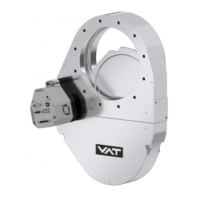INSTALLATION Series
22/129
Edition 2019-05-03 963283EA
4.2.3 Installation procedure
1. Install valve [1] into the vacuum system. Valve seat side should face process chamber. The valve seat
side is indicated by the symbol "∇" on the valve flange.
2. Connect compressed air supply to connection labeled ‘IN’ located at actuator, see Figure 1 below.
Connect compressed air return line connection labeled ‘OUT’ located at actuator, see Figure 1 below.
3. Install the ground connection cable at controller. Refer to «Electrical connection»
4. Install pressure sensor(s) [2] according to the recommendations of the sensor manufacturer and
directives given under «Requirements to sensor connection».
5. Connect sensor cable [3] to sensor(s) and then to valve (connector: SENSOR).
Refer to chapter «Electrical connection» for correct wiring.
6. Connect valve to RS232 [4] (connector: INTERFACE). Refer to «Function and Wiring» for correct
wiring.
7. Connect power supply [5] to valve (connector: POWER). Refer to chapter «Electrical connection» for
correct wiring.
8. This valve has a double sealed rotary feedthrough and optionally an intermediate pumping port for the
actuator shaft. This port (1/8“ ISO/NPT) could be connected to the vacuum line, see Figure 3 below.
9. This valve may optionally be equipped with a heating device. Connect VAT heating device according
to manual of respective heating device.
10. Perform «Setup procedure» to prepare valve for operation.
• Do not tighten the flange screws stronger than indicated under «Tightening
torque».
• Do not admit higher forces to the valve than indicated under «Admissible forces».
• Make sure that enough space is kept free to do preventive maintenance work.
The required space is indicated on the dimensional drawing.
Compressed air pressure must be in the range of:4 - 7 bar / 55 - 100 psi (above
ATM).
• Use only clean, dry or slightly oiled air. IN / OUT connections are 1/8“ ISO/NPT
internal threads.
To provide power to the valve motor pins 4 and 11 must be bridged, otherwise motor
interlock is active and the valve enters the safety mode and is not operative. Refer
also to «Safety mode».
Without performing the setup procedure the valve will not be able to do pressure
control.
OUT
IN
Fig. 1 Fig. 2
intermediate pumping port

